The introduction of the Dreamcast in the Netherlands went anything but smoothly. For a very long time it seemed that the console would never even be released in the country.
Sega hoped the Dreamcast would make the company a major player in the console market again. What was Sega’s position in the Netherlands before the console was announced? How did negotiations with potential distributors go? How did the games media write about the console leading up to its launch? And what did retailers think of it?
This article is a reconstruction of the period before the introduction and the final introduction of the Dreamcast in the Netherlands.
Sega in the Netherlands
Things did not go well for the Sega Saturn in the Netherlands. Sega was a small player in terms of market share and revenue. Sales numbers were extremely low in 1997, with only 2,000 Saturn consoles sold that year. This brought the total number of Saturn consoles in Dutch households to 7,000. Competitors sold much better in the same year: the PlayStation grew from 27,000 to 130,000. The Nintendo 64, which entered the Dutch market in March 1997, sold 63,000.
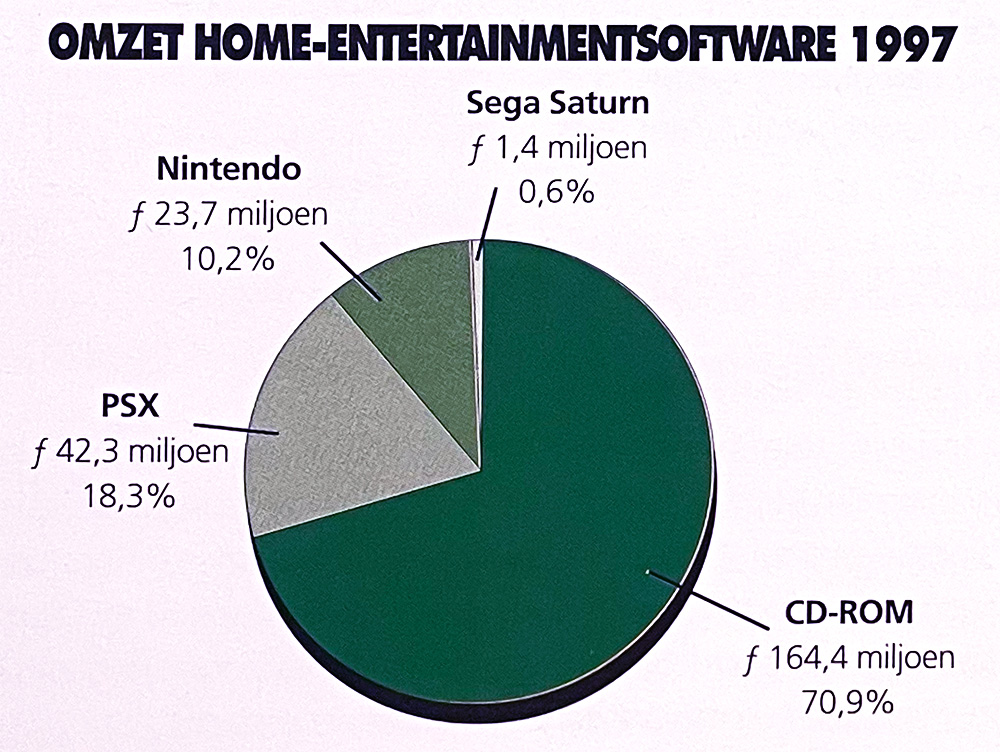
In early 1998, i-Mediate Publishing, the organization behind the Dutch Interactive Charts, decided to stop publishing monthly top 10 sales lists of Saturn games. Reason: declining sales and interest. Atoll Soft was Sega’s distributor in the Benelux (a region consisting of Belgium, Netherlands and Luxembourg) at the time. Daniël Janssens, general manager of Atoll Soft, said in trade magazine MultiMediaMarkt (February 12, 1998) that he was not surprised about the decision. According to him, the Saturn was at the end of its life cycle.
Sony’s PlayStation was about the same age but still growing substantially.
Announcement of the Dreamcast
Rumours and stories circulated for some time that Sega was working on a new console. In early 1998, news about the console became gradually more concrete. On May 21, 1998, Sega announced the Dreamcast. According to Sega, the 128-bit machine would have a big advantage over the other consoles. The built-in modem and the ability to go online with the console were seen as important extras. With this console, Sega wanted to return to the No. 1 position in the console market. The console was to be released in Japan on November 20, 1998. The United States and Europe were scheduled for a year later.
Trade magazine MultiMediaMarkt commented on the announcement in its July 2, 1998 issue. The magazine was impressed with the partners Sega was going to use to make the console. That would make the console very powerful. “The cooperation with giants like Microsoft, Hitachi and NEC ensures that: such big players don’t get involved with a console to make an insignificant product.”
The magazine further anticipated a large market share for the Dreamcast. They felt that Sega had great confidence in the console. “This is evident from the mind-boggling promotional campaign it has planned for the console: the sum total of $500 million will be spent on the launch(!!!). Incredible but true.” The magazine though that surely the PlayStation would appear somewhat outdated at its introduction.
Distribution agreements had to be made for various countries and regions within Europe, including the Netherlands. The Netherlands was sometimes seen as a separate country with its own distributor, but often treated as part of the Benelux (the Benelux is Belgium, the Netherlands and Luxembourg combined).
Sega entered negotiations for distribution in the Benelux with four different distributors: R&P, Contact Data, Audax and Atoll Soft. Talks became most serious with Audax and Atoll Soft.
The negotiations were conducted by Kazutoshi Miyake. He had been involved in Sega’s European affairs since 1993, first as general manager for Sega Enterprises Japan and from 1994 as CEO of Sega Europe.
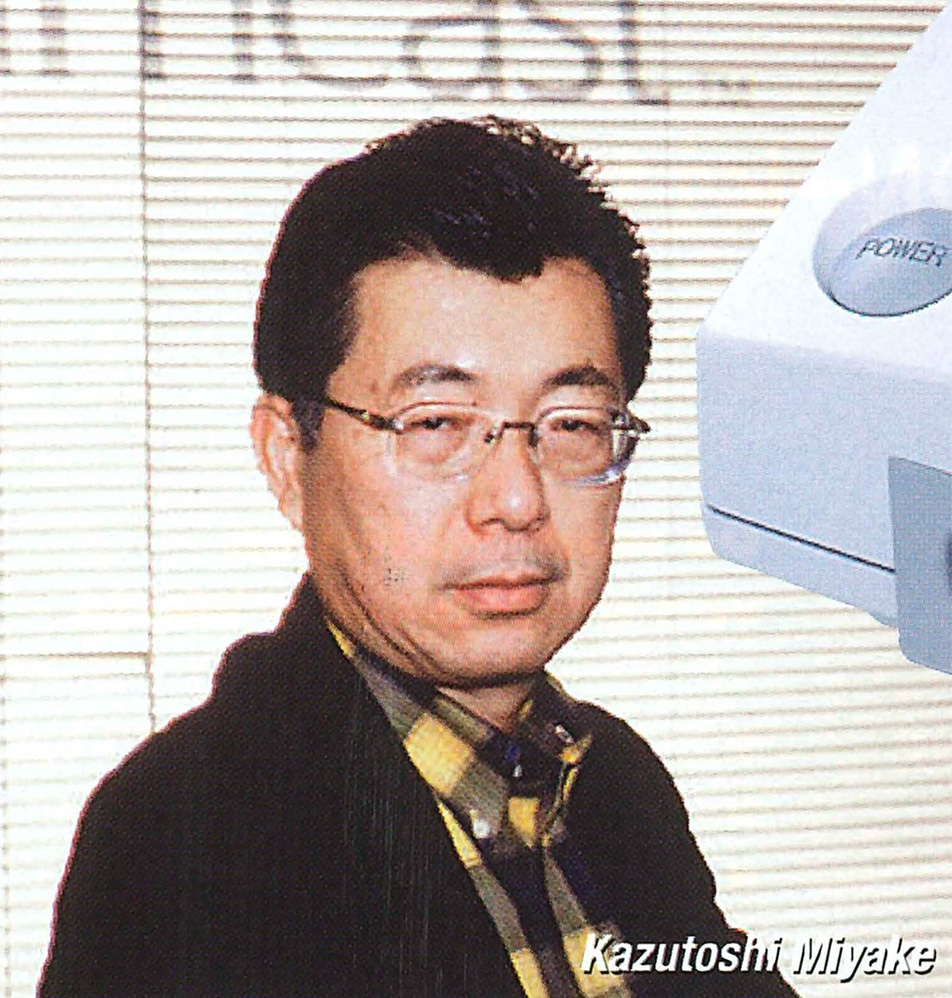
Audax
Audax is a Dutch publisher, distributor and retailer of all kinds of media products, founded in 1958 and still in existence. The company was already active in both the Netherlands and Belgium in 1998.
Audax’s ambition for 1998 was to grow further in multimedia products such as games. In the first half of 1998, the company announced several distribution deals with publishers, with titles such as V2000 for the PlayStation and Johnny Herbert’s GP Championship 1998 for the PC. Audax’s experience in publishing and magazines was seen as a strength. Games that Audax distributed could be highlighted, for example, through its own weekly magazines. The company had no experience distributing consoles.
Audax apparently saw an opportunity in the Dreamcast. The company told Sega it was interested and began negotiations with Sega in September 1998. Miyake visited the company and saw Audax as a potential partner. Talks appeared to be moving swiftly. Audax prepared a business plan that was discussed several times with Sega to sell 100,000 consoles in the Netherlands by 2001.
Towards the end of 1998 Audax was eager to know where things stood. According to the company, Miyake had agreed in December 1998 that Audax would be allowed to bring the Dreamcast to market in the Netherlands. Atoll Soft would be allowed to distribute the console in Belgium.
In early January, the plan was for Miyake to came to Audax for final discussions so that the company could begin the necessary preparations to introduce the console in the Netherlands. However, Miyake never appeared and there was no further communication.
Atoll Soft
Atoll Soft was a Belgian company founded in 1992 that focused on distributing games and accessories in Belgium through a variety of channels: large hypermarkets, wholesalers and, to a smaller extent, independent retailers. In 1993, Atoll Soft decided to focus on the Dutch market as well.
Atoll Soft already had a relationship with Sega. As of March 1996, the company took over distribution from Sega Belgium and Sega Netherlands. But that relationship was apparently not enough to make distribution of the Dreamcast by Atoll Soft a matter of course.
The coverage and comments in the trade magazine MultiMediaMarkt seemed to expect Atoll Soft to be the eventual distributor. For example, on Nov. 19, 1998, MultiMediaMarkt published an article titled about the current affairs at the company. Atoll Soft was in negotiations with Sega, although the article gave very few details. Specific regions, for example, were not discussed.
Audax must have read this article and may have thought something was up. They believed that Sega was negotiating with Atoll Soft only for Belgium. This turned out not to be the case. Daniël Janssens stated the following in an article about the negotiations (CTW Benelux, from May 1999): “We have always negotiated with Sega for the entire Benelux. As far as we were concerned, there was never any question of a different form. I had heard that Audax was also interested, but I did not have that information from Sega.”
In November 1998, Atoll Soft presented its own plan to Sega. In three years, Atoll Soft wanted to sell 100,000 consoles in both Belgium and the Netherlands. After adjusting the plan, the company heard that Sega would decide by the end of December, but there was no news on the decision in December. Just like with Audax, there was no communication from Miyake to Atoll Soft.
Unrest at Sega
By the end of 1998, Audax had a suspicion that Miyake might be in a difficult position at Sega Europe. Things were rumbling at the top of the company and Miyake was replaced as CEO of Sega Europe at the end of the year by Frenchman Jean-Francois Cecillon.
Cecillon had previously been CEO in the music industry at EMI Records U.K. and Ireland. He left the company in April 1998 after 10 years of employment. In addition to Sega Europe, Cecillon would also become responsible for Sega’s direct subsidiaries in the U.K., France, Germany and Spain. Billboard of Dec. 12, 1998, reported that Cecillon said there were many similarities between the music industry and the games industry in terms of volatility and speed.
Miyake did not depart from from Sega Europe and became its COO. He would also continue to handle negotiations for distributing the Dreamcast in the Benelux region.
Stalling negotiations
By the end of February, Audax still had not heard from Miyake. Jack Heijkans, label support manager of Audax, stated in CTW Benelux of May 6, 1999 that this was the moment the company really dropped out. “And then it didn’t really have to be for us anymore. As far as we were concerned, the story was actually closed at that point.”
Heijkans continued, “We had expected a complete plan from Sega to be on the table by January 1. But nothing was known or decided yet. We really had to start at the very beginning, with pre-marketing, plugging and things like that. So that was already out of the question.”
In the world of distributors and trade magazines, stories also circulated that negotiations for the Dreamcast were proving difficult. In MultiMediaMarkt of February 25, 1999, there was a story about an unnamed Dutch distributor, spoken with at a trade show, that had dropped out. This must have been Audax. “We have said we are giving up. Just imagine: getting the introduction of THE new games console on track within a time frame of five months. That’s not doable.”
Besides the lack of communication, lack of time and lack of plans, finances for marketing were a big issue. According to Audax, it would really take 1 million guilders to sell 10,000 consoles in the first three months. Miyake thought that was too much money. Sega wanted to spend little on marketing for the Netherlands.
Atoll Soft also received no communication from Sega for a long time afterwards. Eventually they received word from Sega that there would be a meeting in March 1999. General manager Daniel Janssens said to MultiMediaMarkt of March 25, 1999 that Sega had to provide a marketing budget for the launch campaign, otherwise they would abandon a deal.
Similar to Audax, Atoll Soft could not get an agreement with Sega on this point. Daniël Janssens in CTW Benelux of May 6, 1999: “If you want to reach the masses you have to do it en masse. We needed 2 million guilders (36 million Bfr) for Belgium and the same amount for the Netherlands. The plan was to sell 100 thousand units in both countries within three years. Sega, however, did not want to contribute anything. They wanted to focus only on their key markets: the UK, Germany, France and Spain. That’s where 100 percent of the budget went.”
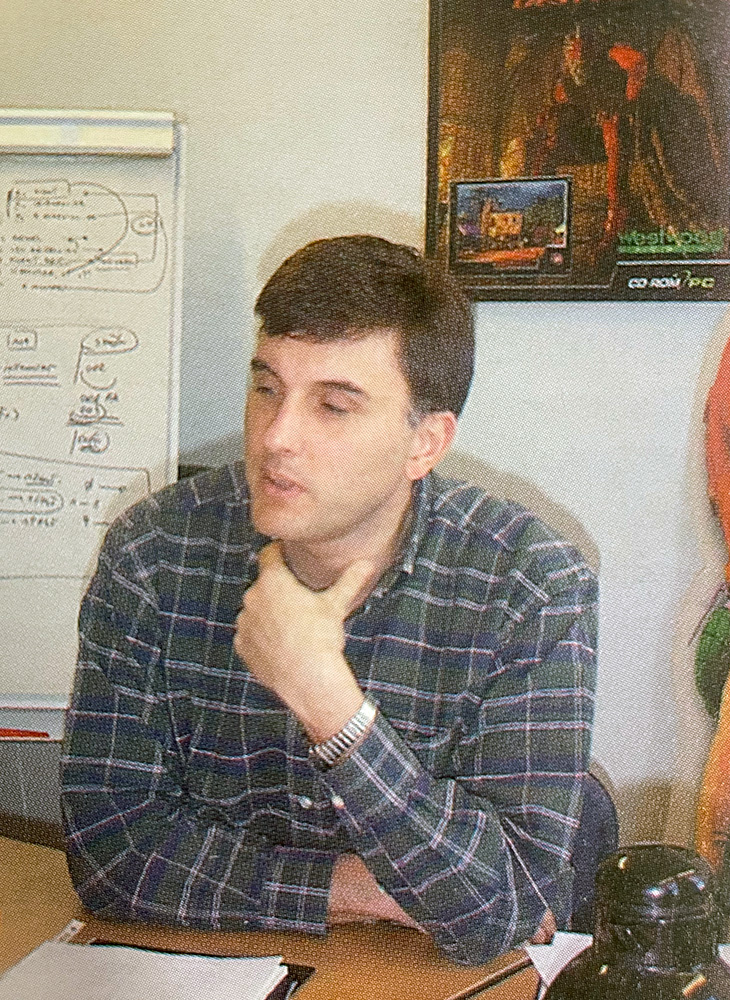
Audax surprisingly received price lists for the Dreamcast via fax on April 15, 1999. Miyake’s assistant called the company with a request to come to London, where Sega Europe was located. Audax declined the invitation.
Atoll Soft even presented another new plan to Sega that would focus entirely on hardcore gamers. The expectation from Sega was that those members of the audience would buy the console anyway. According to Daniel Janssens, the proposal from Sega that followed was “let me express myself diplomatically, not acceptable.” According to Atoll Soft, the prices for the units were ridiculous. Sega still did not want to invest in marketing. On April 16, 1999, Atoll Soft said it was permanently quitting negotiations.
Response from Miyake
Miyake, in a response to trade magazine CTW Benelux from May 6, 1999, stated that he didn’t think Sega did anything wrong. According to Miyake, budget numbers had been leaked to the press, causing parties to start calculating and demanding a certain budget. The leaked amount would have been intended for marketing activities at the European level instead of specific support for a distributor at a local level.
The Sega negotiator said Sega wanted to focus primarily on Europe’s major markets: the United Kingdom, France, Germany and Spain. Those were also the countries where Sega did its own product distribution and had a higher strategic interest. For the Benelux, Sega had very little budget. Miyake also thought the Dutch and Belgian markets were different. “As far as Sega is concerned, by the way, the Belgian market is bigger than the Dutch,” he said.
Miyake stated that a second round of negotiations had begun with new candidates. Which parties were involved was unknown. Meanwhile, five months before the intended sales launch, there was no distributor for the Benelux. The situation was also unclear and difficult for retailers to anticipate. According to Audax, at least eight months would be needed to properly introduce a console. That time frame was now impossible.
Meanwhile, the PlayStation 2 was announced by Sony in March 1999 and it got people thinking. What would that mean for the Dreamcast’s chances? For distributors, the question was whether there was enough time to recoup investments. Daniel Jansen of Atoll Soft: “The first few years after the introduction of the Dreamcast, you won’t earn a dime. So that means you have to see it as a strategic investment to make a profit in three years. That’s dangerous; after all, the console market is riskier than the PC market.”
First impressions Dreamcast
During the negotiations, the first impressions and reviews of the Dreamcast and available games appeared in the Dutch gaming media. The then largest Dutch-language multi-platform magazine Power Unlimited imported a console and some games from Japan. In a February 1999 article, readers got an impression before the console was available in the country.
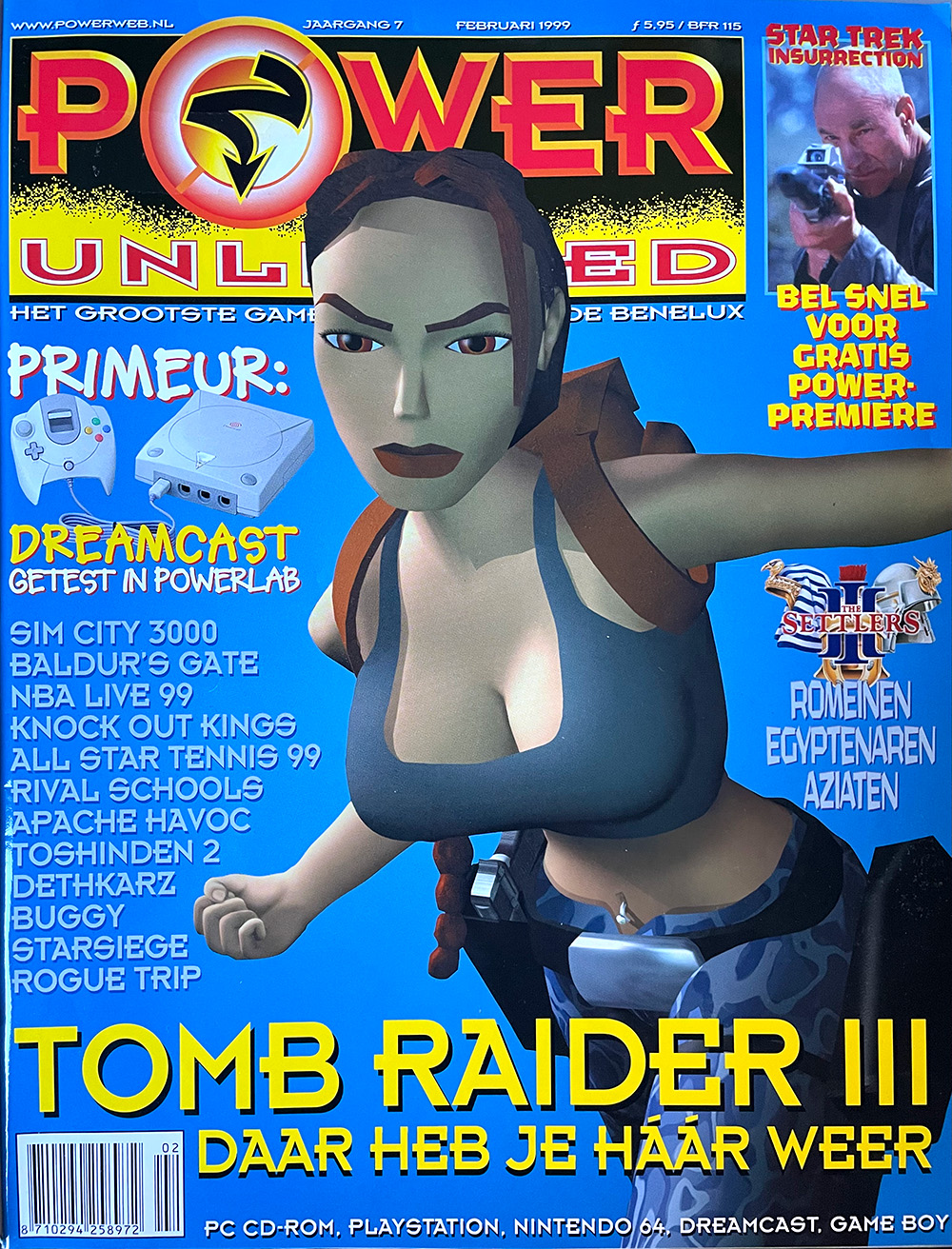
Editor Bjørn Bruinsma wrote the preview. Opinions about the controller were divided on the magazine’s editorial staff. People thought the gamepad was designed too much for small hands, and Bruinsma suffered pain on the edge of his thumbnail due to the digital direction button. “My overall impression of the Dreamcast is that Sega delivered a solid and well thought-out system. However, I still maintain that a console is only as good as the games developed for it, and as you can read in the following pages, there is quite a bit to be said about that.”
Three games were discussed: Godzilla Generations, Virtua Fighter 3TB and Pen Pen TriIcelon. Bruinsma was not enthusiastic about Godzilla Generations. “I rather think this title had to be made quickly because otherwise there was so little to demonstrate the Dreamcast with,” he said. Bruinsma also felt little for Pen Pen Trilcelon. “Frankly, this game disappointed me right away because it was quite childish and looked more like a candy cane party than a flagship game for a new generation of game consoles.”
Bruinsma was a bit more enthusiastic about Virtua Fighter 3TB. “So you can actually ram someone against the fences and it all looks very realistic.” However, the controller for this type of game was not ideal, according to the editor. “Real enjoyment of a fighting game on the Dreamcast will only be achieved if a special joystick is developed for it.”
Bruinsma concluded, “It is quite clear that the Dreamcast is technically better than all its predecessors. The sound is excellent, the graphics even better and the speed leaves nothing to be desired. Unfortunately, this has not yet been translated into good games, such as perhaps Sonic Adventures. Let’s hope that Sega doesn’t make the same mistake it made with the Saturn, but that they start coming out with good titles soon. The device is worth it.”
Little attention for DC in gaming media
Besides the console preview story there was very little coverage of the Dreamcast. The import version of Sonic Adventure still received a good review in the March 1999 issue. Otherwise, reviews of Dreamcast games in the magazine remained sporadic and moderately enthusiastic.
News of the lack of a distributor for Benelux would also reach the readers of Power Unlimited. In the July 1999 issue, which appeared sometime in late June, it was written that there was no distributor yet, and it remained to be seen whether the games the magazine had seen at E3 would be easy to play in the Netherlands.
“Incomprehensible really that nobody here in our country is willing to distribute the device in a decent way, especially when you see what that thing can do. Although representing such a new console obviously involves a lot, just think of marketing budgets and other kinds of support and agreements from and with the manufacturer.”
At the last minute: a distribution deal
Six weeks before its release, a distributor was signed up to distribute the Dreamcast in the Netherlands and Belgium. Even though they abandoned a deal in April, Atoll Soft struck a deal with Sega Europe. The plan was for the Dreamcast to officially launch in the Netherlands on Sept. 23, 1999, like other countries in Europe.
Atoll Soft had been acquired by French company Bigben Interactive in late July. They would continue to focus on the Benelux region.
The acquisition by the larger Bigben Interactive provided the company with a better bargaining position. As a result, they were able to command slightly better terms. Daniël Jansen of Atoll Soft, in an article in CTW Benelux of September 2, 1999, said he was also more convinced about publisher support for the Dreamcast. He also felt that the PlayStation 2 might be delayed for a year, allowing more time for the Dreamcast to grow.
The marketing budget remained limited. 200,000 guilders would be available for marketing from Sega, 10% of the amount Atoll Soft said was required during the initial negotiations. Atoll Soft itself would also invest 200,000 guilders into the process. Sega continued to focus primarily on marketing activities in the major European markets with – for example – t-shirt sponsorships of a number of soccer clubs in those markets.
Marketing in the Benelux was partly focused on retailers. Atoll Soft wanted to roll out a PR campaign aimed at this target group. Furthermore, a deal was struck with Veronica magazine (a weekly magazine from broadcaster Veronica with a target audience of young adults) to reach a wider audience. A large campaign aimed at consumers was not possible with the available budget. It was considered a disadvantage that there was no great diversity of games magazines in the Netherlands. Power Unlimited was not seen as a magazine that targeted the Dreamcast’s intended audience: 18 and older, independent young people with a good income.
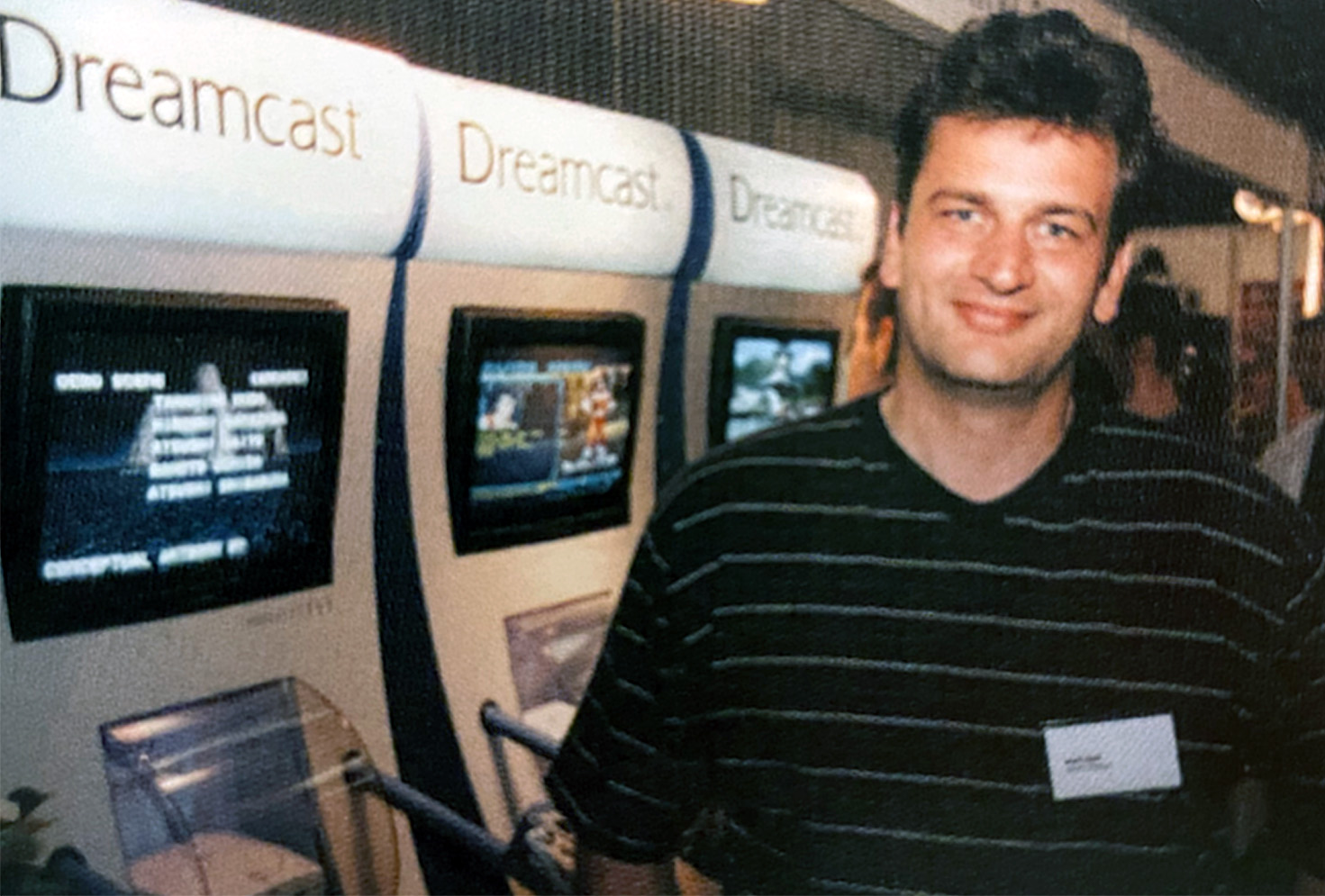
The critical hardcore gaming audience, according to Atoll Soft, had to get a good impression of the console because they would determine the image about the console. Looking at the impressions that had been circulating about the Dreamcast in Power Unlimited, this impression was not overly positive. Many import games did not fully convince the writers. Games like Soulcalibur, on the other hand, were received with great enthusiasm and were seen as truly innovative.
The late deal made it difficult for many large retailers, such as large toy store chains like Bart Smit and Intertoys, to participate in the launch of the Dreamcast. Such organizations normally made decisions about purchasing consoles months in advance. Daniël Janssens of Atoll Soft said in MultiMediaMarkt of August 12, 1999 that this was unfortunate, but according to him, the hardcore games weren’t going there anyway. Janssens said, “And again, the first deliveries will be sold to that group. In the first six months the Dreamcast will not be a mass-market product, after that it will be.”
Meanwhile at Playstation and Nintendo
Meanwhile, the competition had been growing its markets. The Nintendo 64 had continued to grow, with one of the highlights being the launch of The Legend Of Zelda: Ocarina of Time in late 1998.
The PlayStation experienced massive growth in the Netherlands in 1998. While at the end of 1997 the counter stood at 27,000 consoles sold since sales began in 1995, at the end of 1998 the counter stood at 400,000. Most owners of a PlayStation in 1999 had bought the console very recently. Many new titles appeared, for example Metal Gear Solid came out in the Netherlands in 1999, a groundbreaking and innovative title. The console also experienced significant price drops.
Even when the distribution deal with Atoll Soft was announced, the specter of the PlayStation 2 continued to hover over them. Atoll Soft hoped that the PS2 would appear a year later, but the opposite turned out to be true. Sony said around the time of the Dreamcast’s introduction that the console would appear in Japan as early as the first part of 2000. On paper, its specifications were even better than Sega’s console. The PlayStation 2 would also become backwards compatible with games for the original PlayStation.
Finally the introduction: October 14, 1999
The Dreamcast was finally released throughout Europe not on September 23 but on October. 14, 1999. The console was on sale for fl. 599 including a controller and demo disc. The memory card (VMU) cost fl. 79.95. The built-in modem was at first officially unusable in the Benelux, as the network that Sega had to build together with British Telecom (BT) for online functionality was not yet available here.
There were 10 games available on day one:
- Blue Stinger
- Incoming
- Millennium Soldier: Expendable
- Monaco Grand Prix 2
- Power Stone
- Sega Rally 2
- Sonic Adventure
- Speed Devils
- Trick Style
- Virtua Fighter 3tb
There was no major campaign targeting consumers for the upcoming launch. Magazines and websites aimed at gamers wrote about the release. In the October 1999 Power Unlimited, published on September 24, 1999, there was a brief news item that the console would finally be released. That was three weeks before the new launch date. Other than that, there was little to read about the game console in the issues for September and October.
Veronica’s weekly magazine published an article about the Dreamcast (though after October 14). Atoll Soft set up its own website and sent out press releases. Some potential buyers were likely alerted to the upcoming launch through specialized game stores and several also took pre-orders for the console.
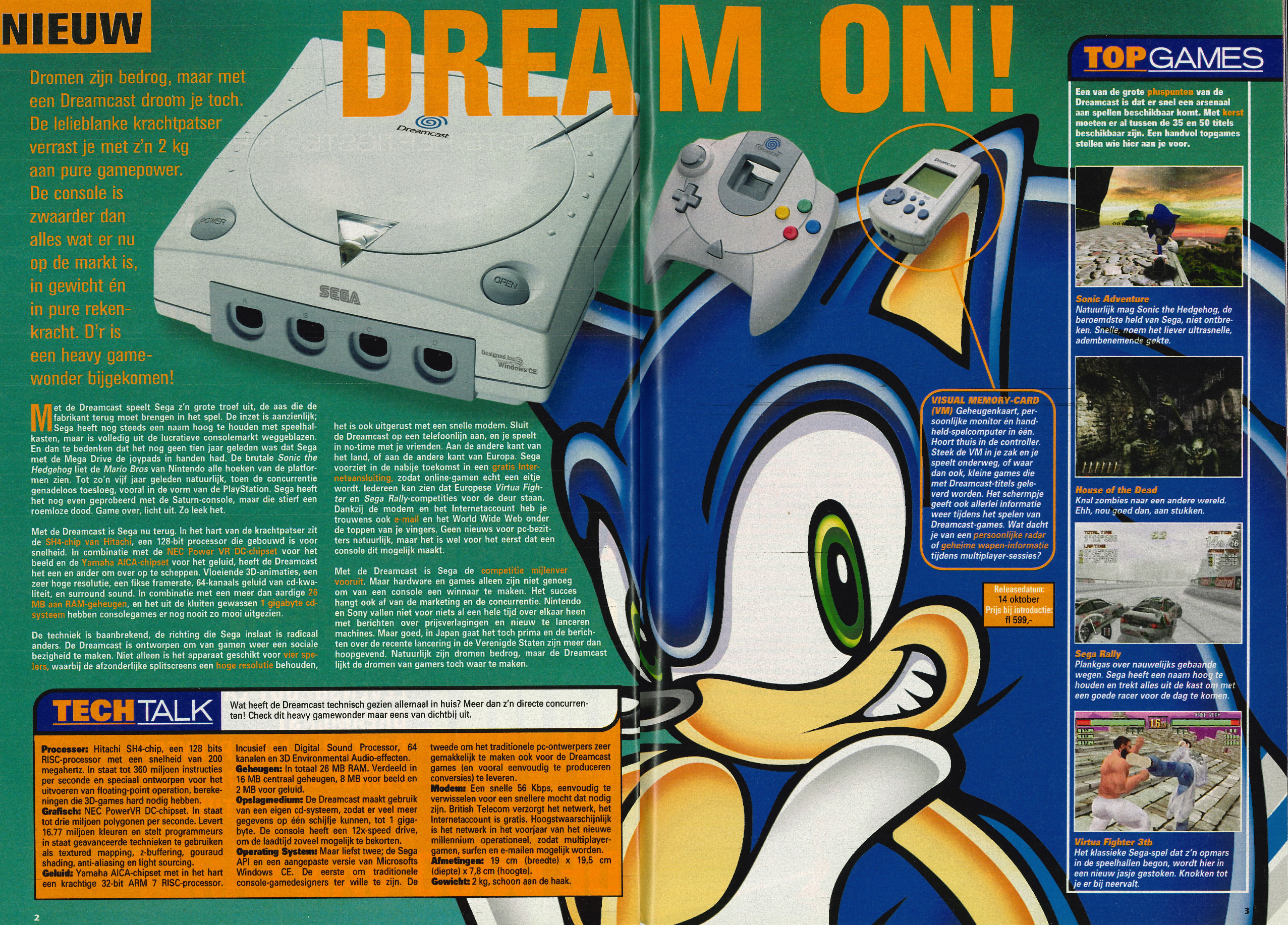
Retailers had to make do with far fewer consoles than the expected 10,000 on launch day. Atoll Soft was only able to deliver about 2,500 consoles to retailers in the Netherlands and about 3,000 consoles in Belgium. Against expectations, larger chains like Bart Smit and Free Record Shop still had some Dreamcast consoles on sale on the day of introduction, but they had not been able to do extensive marketing, something that specialized game stores regretted. After all, they could also benefit from such marketing for awareness among a wide audience about the upcoming launch.
There was uncertainty as to whether Sega could make good on the backorders before Christmas. Gerard Schepper, product manager at Atoll Soft, stated in MultiMediaMarkt of November 4, 1999 that another larger shipment of Dreamcasts would not arrive from France until January. So around Sinterklaas and Christmas, important days in December for sales in terms of gifts, he said there would be poor availability of the console in the Netherlands.
Not all stores were able to honor their pre-orders on Day 1, but some stores did not sell their entire stock on that day either. In CTW Benelux of October 28, 1999, some stores gave insight into their sales. Fame on the Kalverstraat in Amsterdam sold 20 consoles of the 70 they received. Gameshop No Limit received 8 consoles, all of which were also sold, but actually ordered 50 consoles. Gameshop Next-Gen, according to store manager Peter Berkhout, “had to disappoint two hundred customers because it did not receive consoles from the importer.”
Although Atoll Soft was enthusiastic about the introduction, retailers looked back on it with mixed feelings. in MultiMediaMarkt of November 4, 1999, some gave their opinion. Ton Luster of Flevo Games thought it had still gone reasonably well, but the marketing – in his opinion – was very poor. Patrick Hoek of No Limit also thought the marketing was thin. “Normally, gamers should know that a new console is coming to market. With me, gamers came in and saw for the first time that the Dreamcast was out. This should obviously not be possible.”
After the introduction: PS2 causing doubts
In October 1999, news of the upcoming PlayStation 2 was once again plentiful. Power Unlimited had the opportunity to try out the console in Japan and wrote praise about it in its November 1999 issue.
An article in the same Power Unlimited also discussed the Dreamcast. Should you buy this console now that it was available in Europe and the Netherlands? They were not yet enthusiastic about the software. “We have seen too many games that looked graphically perfect, but struggled to score a seven out of ten because, after all, a good game is different from a cartoon.”
The lack of the online functionality and the lack of clarity as to when it would be available was also felt by the magazine to be a major omission. The editors advised readers to wait for the Dreamcast, in both the article and in responses to letters in their letters section. “The games have to be developed specifically for it, so only the second generation of Dreamcast games will you be able to play online. If you add to this the high purchase price of all the Sega stuff, it will become clear that the Dreamcast is not for everyone. In any case, we advise you to wait until it is clear exactly what the Internet possibilities are.”
Whether Sony intentionally timed news to beat out the Dreamcast was hard to prove, but regardless of whether or not this was the case, the effect is that the news created doubt. Peter Moore, who worked at Sega of America at that time, would in a 2021 roundtable for Microsoft’s Alumni Network YouTube channel claim that Sony was deliberately creating fear, uncertainty and doubt with announcements about the impending PlayStation 2.
Some retailers also thought PlayStation 2 could throw a spanner in the works. Niels Thomassen of Nedgame from Apeldoorn in MultiMediaMarkt of November 4, 1999: “Still, I think there is no real future for the DC. When PSX2 hits the European market next fall, everyone will flock to it. It is therefore essential for Sega to bring as many games as possible to the market very quickly, because only with many games will the Dreamcast start to sell.”
A glimpse into the future
The story of the Dreamcast’s introduction, in this author’s opinion, foreshadowed how the console would fare in the Netherlands. Did the Dreamcast do better in the Netherlands than the Sega Saturn? It doesn’t seem so. CTW Benelux in their March 2001 issue analyzed the news that Sega was pulling the plug on the Dreamcast. According to distributor Atoll Soft, 20,000 units had been sold in Belgium & the Netherlands. However, the magazine itself estimated based on game sales figures that it was only 7,000-8,000 units.
Great games were released on the Dreamcast, but the console was never able to reach a truly wide audience. In late January 2001, Sega announced that it would stop making new Dreamcast consoles. The company was making huge losses. New games would still be released, however. Sega would focus on making software for other consoles.
This story was originally published in Dutch at https://www.gamegeschiedenis.nl/2023/01/hoe-de-sega-dreamcast-bijna-aan-nederland-voorbij-ging/
Special thanks to: Calvin Foe & Bastiaan Vroegop
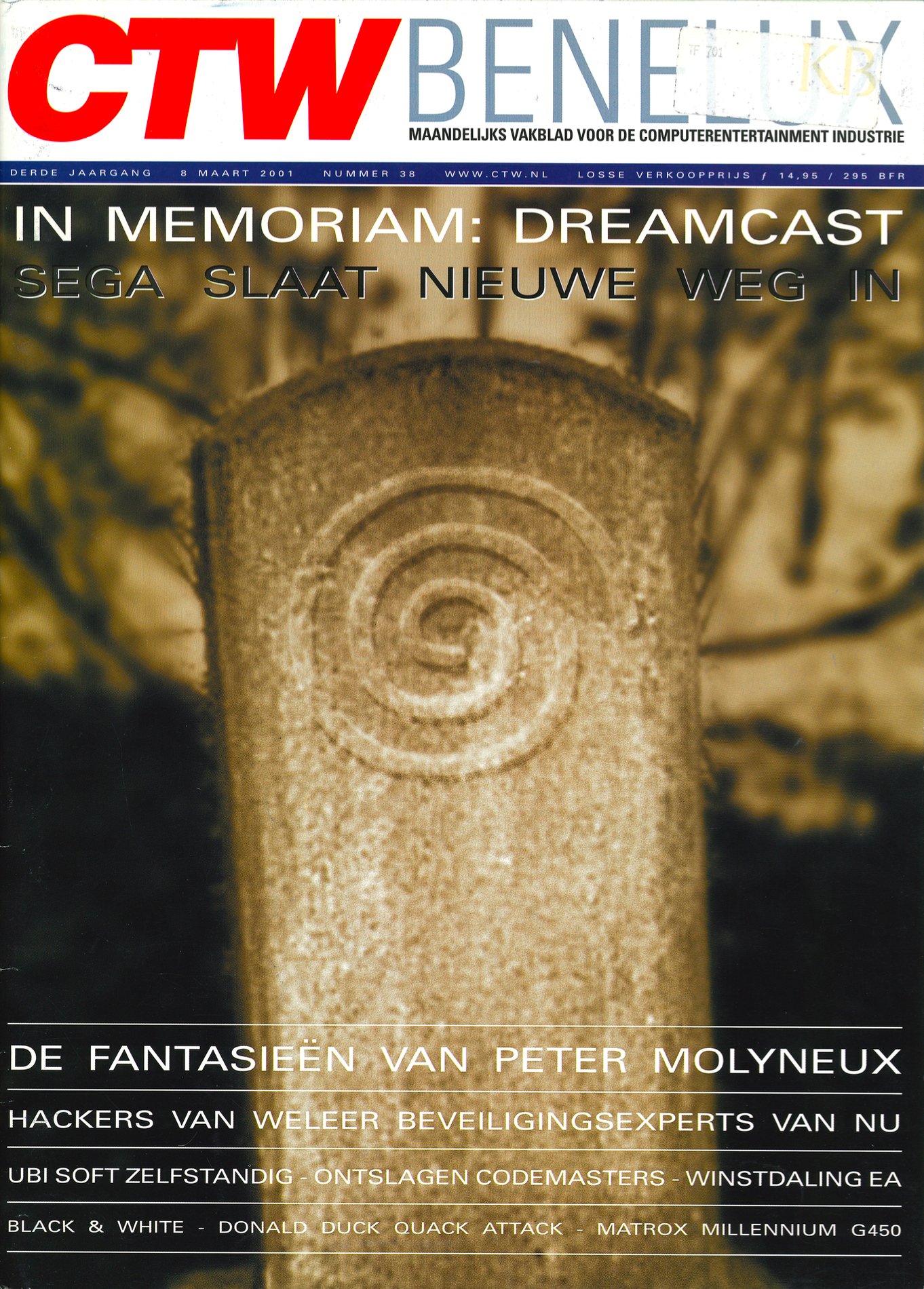
Sources
‘23/9 is Dreamcastdag, maar bij wie?’ MultiMediaMarkt, vol. 4, nr. 10, 6 mei 1999, p. 5.
‘1998 jaar van Playstation’. MultiMediaMarkt, vol. 3, nr. 26, 17 december 1998, pp. 10–13.
‘Atoll druk met Dreamcast en Blue Byte’. MultiMediaMarkt, vol. 3, nr. 24, 19 november 1998, p. 3.
‘Atoll Soft’. Sega Retro, 16 november 2022, https://segaretro.org/Atoll_Soft.
‘Atoll Soft bedrijfsprofiel’. atollsoft.be, 16 augustus 2003, https://web.archive.org/web/20030816150240/http://www.atollsoft.be/html/nl_aboutus.cfm.
‘Atoll Soft distribueert Dreamcast’. MultiMediaMarkt, vol. 4, nr. 19, 9 september 1999, p. 21.
‘Atoll Soft richt vizier op Nederland’. MultiMediaMarkt, vol. 4, nr. 7, 23 maart 1999, pp. 10–11.
‘Audax gaat nu echt beginnen’. MultiMediaMarkt, vol. 3, nr. 9, 23 april 1998, pp. 8–9.
‘Audax van start met vijf labels: software van 8 tot 80’. MultiMediaMarkt, vol. 3, nr. 17/18, 13 augustus 1998, pp. 21–22.
‘Audax verder gamesmarkt op’. MultiMediaMarkt, vol. 3, nr. 8/9, 9 april 1998, p. 5.
Boersma, Gerben-Jan. ‘Van leer & vermaak: Dreamcast, de gameshop en de keten’. MultiMediaMarkt, vol. 4, nr. 4, 11 februari 1999, p. 8.
Bruinsma, Bjørn. ‘PU Introduceert: De Dreamcast’. Power Unlimited, vol. 7, nr. Februari 1999, februari 1999, pp. 30–33.
—. ‘Review: Pen Pen Trilcelon & Godzilla Generations’. Power Unlimited, vol. 7, nr. Maart 1999, maart 1999.
—. ‘Review: Sonic Adventure’. Power Unlimited, vol. 7, nr. Maart 1999, maart 1999, pp. 22–23.
—. ‘Tech Talk: Nieuwe naam, nieuwe kansen’. Power Unlimited, vol. Jaargang 6, nr. Juli/Augustus 1998, juli 1998, p. 11.
‘Conclusies van Sibbel & Van Pelts Multimedia Monitor 1997’. MultiMediaMarkt, vol. 3, nr. 8, 9 april 1998, p. 7.
de Koning, Kees. ‘Review: Virtua Fighter 3TB’. Power Unlimited, vol. 7, nr. Maart 1999, maart 1999, pp. 38–39.
‘De krenten uit de pap: Dreamcast’. Power Unlimited, vol. 7, nr. Juli 1999, juli 1999, p. 67.
‘De nieuwsmaker: Dreamcast’. MultiMediaMarkt, vol. 3, nr. 14, 2 juni 1998, p. 4.
Dierckx, Matthijs. ‘Dreamcast een boze droom…’ CTW Benelux, vol. 1, nr. 3, 6 mei 1999, pp. 32–34.
‘Dreamcast Day One’. CTW Benelux, vol. 1, nr. 13, 28 oktober 1999.
‘Dreamcast in september op Europese markt’. MultiMediaMarkt, vol. 4, nr. 5, 25 februari 1999, p. 4.
‘Dreamcast komt!’ Power Unlimited, vol. 7, nr. Oktober 1999, 24 september 1999, p. 27.
‘Dreamcast op 14 oktober f599,- in schappen’. MultiMediaMarkt, vol. 4, nr. 19, 9 september 1999, p. 3.
‘Dreamcast toch gedistribueerd door Atoll’. MultiMediaMarkt, vol. 4, nr. 17/18, 12 augustus 1999, p. 5.
‘Droommachine geïntroduceerd’. MultiMediaMarkt, vol. 3, nr. 22, 22 oktober 1998, p. 4.
‘ECTS drukker dan ooit, maar waarom?’ MultiMediaMarkt, vol. 4, nr. 20, 23 september 1999, pp. 10–13.
‘Game Guide: De hotste, heftigste & nieuwste games’. Veronica, vol. 1999, nr. 43, 23 oktober 1999.
‘Introductie Dreamcast succesvoller dan release Playstation’. MultiMediaMarkt, vol. 4, nr. 22, 4 november 1999, p. 13.
‘Introductie Dreamcast verder uitgewerkt’. MultiMediaMarkt, vol. 4, nr. 8, 8 april 1999, p. 6.
‘Katana op 21 mei onthuld’. MultiMediaMarkt, vol. 3, nr. 11, 21 mei 1998.
‘M3 beleeft zeer geslaagde eerste editie’. MultiMediaMarkt, vol. 4, nr. 21, 7 oktober 1999, pp. 10–13.
‘Milia 99: Minder bezoekers, maar betere beurs’. MultiMediaMarkt, vol. 4, nr. 5, 25 februari 1999.
‘Playstation legt lat nog stukje hoger – Ronnie Hoekman: “Installed base ligt eind 1998 op 400.000”’. MultiMediaMarkt, vol. 3, nr. 10, 7 mei 1998, p. 21.
‘Powerplay: Dreamcast’. Power Unlimited, vol. 7, nr. November 1999, november 1999, p. 80.
‘Sega Appointment Shifts Cecillon to Game Bix’. Billboard, 12 december 1998, p. 51.
‘Softwareomzet ’97 gestegen met 61%; console gestegen met 315%’. MultiMediaMarkt, vol. 3, nr. 8, 9 april 1998, p. 3.
‘Superconsole moet Sega terugbrengen aan de top’. MultiMediaMarkt, vol. 3, nr. 12, 5 juni 1998, p. 3.
‘“Valse start” Dreamcast’. MultiMediaMarkt, vol. 4, nr. 20, 23 september 1999.
‘Valse start Dreamcast’. Power Unlimited, vol. 7, nr. December 1999, december 1999, p. 13.
van Opstal, Iris. ‘Dreamcast: de aanhouder wint’. CTW Benelux, vol. 1, nr. 10, 2 september 1999, pp. 12–17.
van Opstal, Iris. ‘In memoriam: Dreamcast’. CTW Benelux, vol. 3, nr. 38, 8 maart 2001, pp. 14–17.
‘Xbox Pioneers: Creativity & Innovation — Past, Present & Future’, 22 november, 2021 https://www.youtube.com/watch?v=tadtqchbbh0
Header image: https://commons.wikimedia.org/wiki/File:Dreamcast_PAL_Set.j

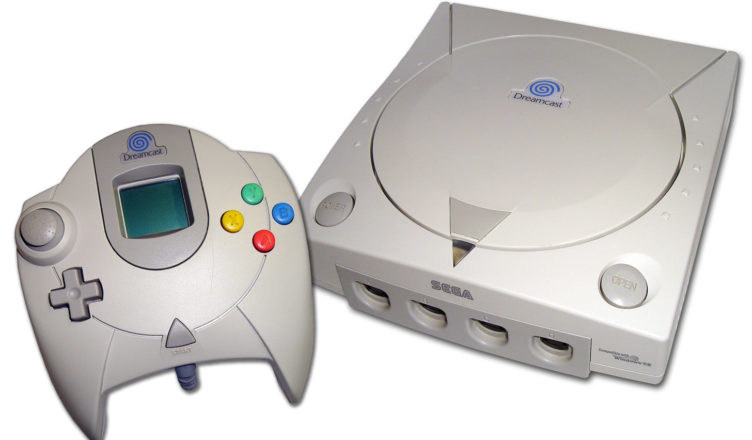





A fantastic piece! I’ve always been curious about how the Dreamcast was received outside of it’s ‘key’ markets. Would pounce on a follow-up exploring the post-launch fortunes of the DC in the Benalux countries if you get the chance to author one.